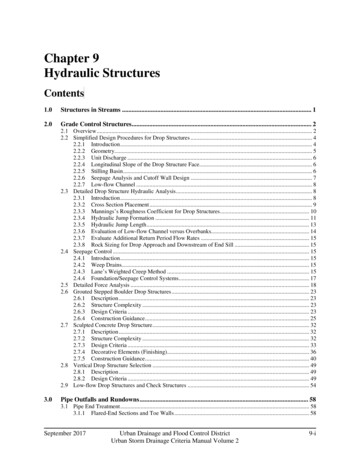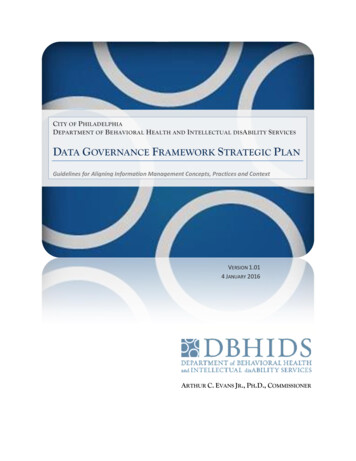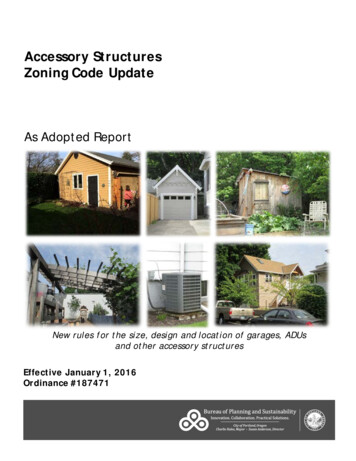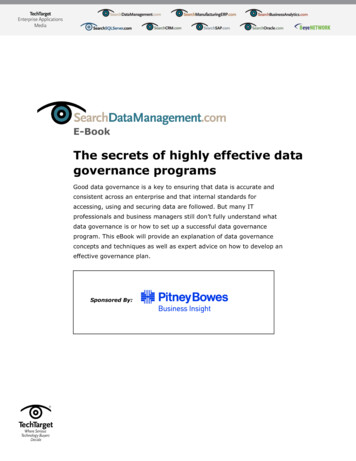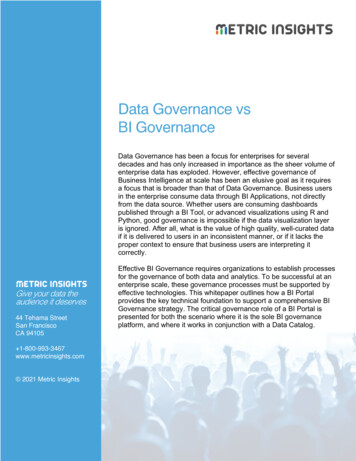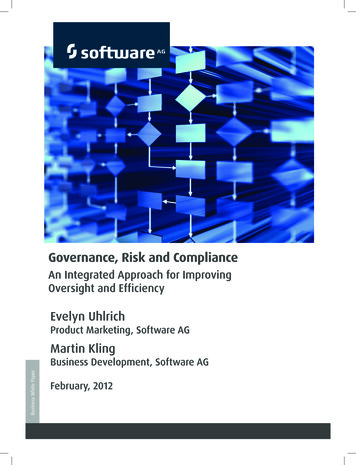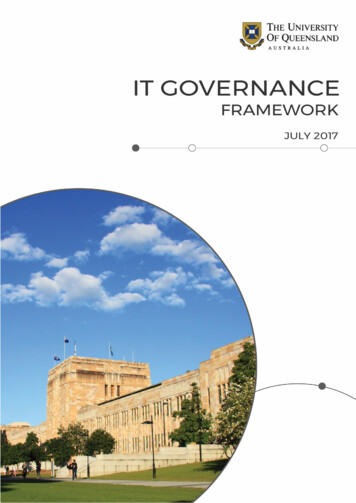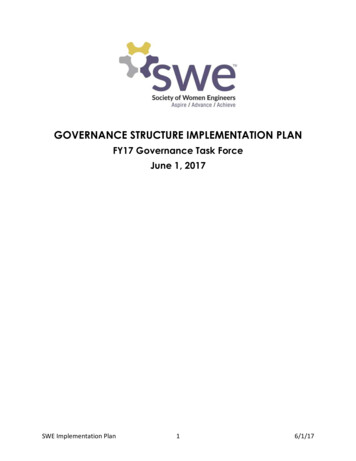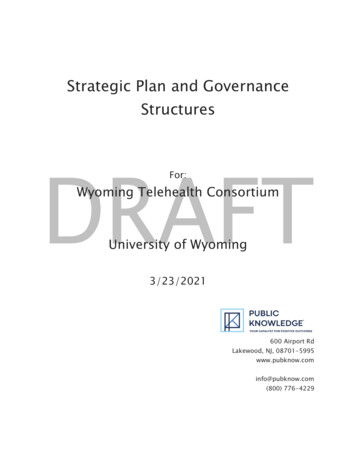
Transcription
Strategic Plan and GovernanceStructuresFor:Wyoming Telehealth ConsortiumUniversity of Wyoming3/23/2021600 Airport RdLakewood, NJ, 08701-5995www.pubknow.cominfo@pubknow.com(800) 776-4229
Table of ContentsTable of Contents12345Executive Summary11.1Wyoming Telehealth Consortium Overview11.2Project Goals21.3How to Use this Plan and Next Steps2Methodology32.1Approach42.2Visioning Session and Initial Findings Session42.3Survey Data42.4Strategic Plan52.5Governance Structures5Mission, Values, and Target Audiences63.1Mission of the Wyoming Telehealth Consortium63.2Values of the Wyoming Telehealth Consortium63.3Target Audiences73.4Consortium Members7Issues and Goals84.1Barriers to Overcome84.2Challenges84.3Short Term Goals94.4Long Term Goals10Governance Structures115.111Steering Committee5.1.16Executive Leadership Team125.2Committees145.3Individual Consortium Members Responsibilities145.4Consortium Meeting Structures14Next Steps17
Table of Contents6.1Consortium, Steering Committee, Executive Leadership Team Next Steps17-176.2Strategic Partners and Outreach Committee Next Steps17-196.3Finance Committee19Appendix A: Project Overview21-21Appendix B: Visioning Session Agenda22Appendix C: Visioning Session PowerPoint24Appendix D: Visioning Session Participants31Appendix E: Initial Findings Session Agenda32Appendix F: PowerPoint, Initial Findings Session34Appendix G: Wyoming Telehealth Consortium Survey43Appendix H: Governance Session Agenda44Appendix I: PowerPoint for the Governance Session46Appendix J: Team Charter Template49
Executive Summary1Executive SummaryThe Wyoming Telehealth Consortium (WTC or Consortium) contracted with PublicKnowledge to facilitate the creation of a strategic plan and governance structures toaddress and accomplish short and long term goals in order to meet the mission of theConsortium. The strategic plan and governance structures is intended to guide andorganize the work of the Consortium for 2021-2022 and into the upcoming five years.1.1Wyoming Telehealth Consortium OverviewThe Wyoming Telehealth Consortium was created in 2009 (W.S. 9-2-117) to promotetelehealth in Wyoming. This was to include the Wyoming Department of Health and theWyoming Department of Enterprise Technology Services (ETS).Until SFY 2017, the state had appropriated 235,000 per biennium to the WyomingDepartment of Health for telehealth efforts, which were completed by Wyoming TelehealthNetwork at the University of Wyoming. However, this funding was eliminated beginning inSFY 2017. At this time, telehealth is currently not funded through Wyoming legislation.Funding for the development of the Wyoming Telehealth Network (WyTN) is currentlyprovided through the Wyoming Department of Health (WDH), Healthcare Financing(Wyoming Medicaid) and the Office of Rural Health along with the University of Wyoming.This current funding supports 1.5 FTE and a secure video-conferencing system withHIPPA-secure licenses, ZoomTM.The Wyoming Telehealth Network (WyTN) currently administered at the University ofWyoming-College of Health Sciences supports healthcare entities, providers, andspecialists to increase access to care and improve health outcomes for Wyoming residents,through professional development, collaboration, and telecommunications technology.Current core activities include statewide training and education, technology and clinicalservices.Current needs for training, technical assistance support and evaluation of telehealthservices in Wyoming communities outweigh current resources. As of September 18, 2020,WyTN have enrolled 2285 providers, primarily in the areas of primary care (419), mentalhealth (784), pediatrics, emergency medicine, and allied health (physical therapy,occupational therapy, and speech-language pathology) (406): Total of 1609 of 2285providers, 70%.In order to continue to meet the current demand and sustain ongoing services, investmentis needed in the following areas:WY Telehealth Consortium Strategic Plan3/23/20211
Executive Summary Infrastructure for state coordination to include education and training, policy,billing, technology, advocacy of direct clinical services (Wyoming TelehealthNetwork) Provide enhanced training to Wyoming healthcare providers on best practicesrelated to telehealth services, including, developing and maintaining a certificationprocess for clinics and providers to obtain (Wyoming Telehealth Network) Healthcare entity/Healthcare provider grants to support direct telehealthimplementation (monitored through the Wyoming Telehealth Network) Increase broadband access for healthcare providers and patients (Wyoming BusinessCouncil) Pre-service education and training for future health care providers (WyomingTelehealth Network with University of Wyoming and Community Colleges clinicaleducation programs) Research and evaluation of best practices and return on investment (WyomingTelehealth Network) Marketing and outreach of the Wyoming Telehealth Network (Wyoming TelehealthNetwork)1.2Project GoalsThe Consortium succeeded in meeting initial goals. With growing demand for telehealthsince the COVID – 19 pandemic, the Consortium wants to set and prioritize new goals bycreating a strategic plan to address funding, growth, continued interest, and governance.In 2020, the Wyoming Telehealth Consortium’s membership grew dramatically, increasingfrom 400 active members to more than 2,500. The Consortium wants to work with allmembers to collaboratively create a vision, design the future funding model, and identify agovernance structure including roles and responsibilities, policies, and procedures.1.3How to Use this Plan and Next StepsThis plan is intended to guide and organize the work of the Consortium over the next fiveyears. Consortium members can use this guide the work and direct activities of theConsortium. Suggested next steps for the Consortium are as follows:1. Review governance structures, identify any additional needs or gaps2. Implement governance structures3. Define WDH and WyTN roles, review strategic plan goals, assign to committeesAdditional next steps can be found here.WY Telehealth Consortium Strategic Plan3/23/20212
Methodology2MethodologyPK began our strategic planning work by communicating with the Consortium leadership togain a deep understanding of the issues it faces. Consortium leaders and stakeholdersknow their organization, we invested time upfront to gain an empathetic view of theirneeds and goals. Through careful listening and expert analysis, we helped the Consortiumdefine the scope and vision of the project, along with strategies to help achieve a strategicplan and governance structures that addresses barriers and risks.This is an integrated approach to strategic planning, resulting in strong consensus arounda realistic, achievable, and measurable plan. Pk’s consultants used this approach to achievethe following outcomes: Environmental scan to understand current issues, pain points and gaps. Team ownership of the vision, including the goals and steps to achieve the goals. Consensus when possible, and identification of barriers when not possible, alongwith practical steps to manage the remaining differences. An actionable plan with defined priorities and recommended next steps. A means of communicating accountability to stakeholders to show progress onissues that matter to them.Figure 1. Strategic Planning ApproachWY Telehealth Consortium Strategic Plan3/23/20213
Methodology2.1ApproachPK took the following approach, described below, to identify the Consortium’s needs anddevelop the strategic plan and governance structures.2.2Visioning Session and Initial Findings SessionThe Consortium and its members participated in a two-hour virtual visioning session onJanuary 26, 2021. The agenda for the visioning session is located here. PK used groupfacilitation methods from Technology of Participation (Institute of Cultural Affairs) toreview and collect information and feedback on the following topics: Draft Consortium mission statement and target audience description Brainstorming the Consortium’s future state, including what problems theConsortium is trying to solve Challenges and barriers the Consortium faces in its workThe PowerPoint presentation from the visioning session is located here, along with adetailed participant list located here from the visioning session.An initial findings session was held on February 23, 2021. The agenda for the initialfindings session is located here. In the initial findings session, Consortium membersdiscussed the following: Review of the draft mission statement and discussion of the definitions of what isthe Consortium’s definitions of organizations and stakeholders Review of values and discussion of what values are missing Discussion of the Consortium’s target audiences, including who the Consortiumshould consider as members versus who the Consortium serves Identification of organizations that duplicate the work of the Consortium Continued discussion of identification of needsThe PowerPoint presentation from the initial findings session is located here.2.3Survey DataFor Consortium members who were not able to participate in the visioning session orfollow up initial findings session, a survey (found here) was sent to collect additionalinformation. Data including in the findings section reflects survey data gathered fromrespondents to the survey.WY Telehealth Consortium Strategic Plan3/23/20214
Methodology2.4Strategic PlanAll information and data gathered in the visioning session, initial findings session, andsurvey data was analyzed and provided in this strategic plan report. The report includes thevision, needs, objectives, mission statement, and goals and recommendations in acomprehensive strategic plan.2.5Governance StructuresGovernance, structure, and processes will assist the Consortium in implementing thestrategic plan, assuring strong agreement among team members regarding structure of theorganization, decision making responsibilities, communication structures, and policies. PKfacilitated a two-hour governance session to determine governance, structure, andprocesses for the Consortium. The agenda for the governance session is located here.Consortium members discussed the following during the governance session: Roles, responsibilities, and who should serve on the Consortium LeadershipCommittee What roles the WDH and WyTN should have on the Consortium Discussion of potential Consortium subcommittees, including Legislative, Finance(Membership, Sponsorship, and Funding), and Education Voting structures for the ConsortiumThe PowerPoint for the governance session can be found here.WY Telehealth Consortium Strategic Plan3/23/20215
Mission, Values, and Target Audiences3Mission, Values, and Target Audiences3.1Mission of the Wyoming Telehealth ConsortiumThe Wyoming Telehealth Consortium (WTC) exists to enhance collaboration and alignmentbetween collaboration organizations, key stakeholders, and consumers to promotetelehealth initiatives in order to improve equity in and access to health services inWyoming.The Consortium discussed several definitions of organizations, stakeholders, andconsumers to distinguish the groups, below is a summary of the themes of the definitions.Table 1. DefinitionsOrganizationsAn organization is a group of people with the purpose of ensuringtelehealth access to all Wyoming consumers.StakeholdersA group or individual with an interest in the success of provisioningtelehealth services.ConsumersA consumer is anyone who utilizes telehealth services or would beimpacted from the planning being done by the Consortium.3.2Values of the Wyoming Telehealth ConsortiumThese are the core values of the WTC:Figure 2. ValuesEnhanceCollaboration The WTC works to share knowledge within the Consortium and collaboratewith other organizations to improve access and quality of care usingtelehealth. We operate with a spirit of cooperation to achieve our collaborative goals.Strive for ContinuousImprovement The WTC commits to implement best practices while also conducting aperiod Consortium evaluation. With the evaluation results the Consortiumwill make adjustments to be more efficient and work towards the commongood and improved health.Expand Access The WTC is dedicated to finding solutions in order to provide telehealthservices to all Wyoming residents regardless of location, income, disability,race/ethnicity, sexual orientation, gender identity, and age.Create a CollectiveImpact The WTC understands the importance of stakeholder input. WTC’sstakeholders are from private and public organizations with a diverse andcohesive prospective on telehealth that will assist with the advancement ofWTC’s mission. Expand on this. Add to agenda for next meetingWY Telehealth Consortium Strategic Plan3/23/20216
Mission, Values, and Target Audiences3.3Target AudiencesThe WTC target audiences that it serves including groups and individuals that aretelehealth champions who utilize telehealth services or support telehealth education andadvocacy initiatives in Wyoming.3.4Consortium MembersGroups and individuals who are focused on providing access to care through telehealth aswell as health care advocates in the nonprofit sector.Any person or organization that is a stakeholder or has an interest or can benefit from thework of the consortium. In reality it should be everyone in Wyoming.Champions of Telehealth work, physician champions, hospitals, broadband providers, somany involved, champ organization, stakeholder and consumers anyone who has aninterest in our mission and intent to support improving healthcare outcomes.During the Visioning Session, Consortium members discussed potential missingstakeholders, including the following: Aging Education Department of Family Services Department of Corrections Consumers AARP Patient Family Advisors Wyoming Health Council Professional Licensing Boards Nontraditional partners, such as senior centers, that can act as connectors to largeraudiences that will benefit from telehealth servicesWY Telehealth Consortium Strategic Plan3/23/20217
Issues and Goals4Issues and Goals4.1Barriers to OvercomeConsortium members discussed barriers to overcome to fulfill the mission of theorganization. Lack of direction and structures holds the organization back from makingprogress. Telehealth is broad topic. Without a clear role and vision for the organization, itcan be difficult to be effective. Lack of knowledge about telehealth for the general publicand providers is another barrier. For providers and patients alike, telehealth is newconcept. For providers, there are misconceptions that telehealth is expensive, or providersare simply comfortable with the traditional method of delivering medical services. Forpatients, many are unaware of the availability of telehealth services while others questionthe quality of healthcare that telehealth can provide.Additional barriers identified includes: More time and thought needed towards intuitive information technology andeducating the consumer Flexible policies that we have due to the pandemic might go away; how do weprotect policies that have been beneficial? Lack of payor parity Lack of money Fear of change Telehealth meetings lack specific goals After every meeting, what did we accomplish? Most times that answer is little tonone. Does what’s being presented impact members in consortium? Meetings are hard to follow, members have had struggles understanding why we arehere A clearer vision could help re-engage members and establish redirection Building collaboration with state agencies Leveraging patient, agency, and other advocates4.2ChallengesConsortium members identified the following challenges and issues (listed below) as a partof the visioning session. The Consortium developed the strategic plan with thesechallenges and issues in mind.WY Telehealth Consortium Strategic Plan3/23/20218
Issues and GoalsTable 2. Challenges and IssuesLack of access to telehealthservicesTelehealth has the ability to become a primary method ofhealthcare delivery. Currently, telehealth is underutilizedand needs to be expanded as a service to moreWyomingites.Lack of telehealth educationand awarenessTelehealth is new to the healthcare industry and topatients alike. Many are unaware of the telehealthconvenience and capabilities, while others lack confidencein its quality of care.Lack of fundingFunding is crucial to the WTC and telehealth access.Funding allows WTC to remain operating and sustainable,while also providing access to telehealth technology toproviders and patients. Need for legislativeThe Wyoming legislature is an influential group that isinfluence, advocacy,important to drive forth the momentum of WTC initiativesand ability to driveand mission. Patients who need and can benefit frompolicytelehealth services often have the most difficult timeaccessing telehealth services. State policies do notcurrently support the use of telehealth services.Difficulties with BroadbandaccessRural and remote communities have difficulties withaccess to the internet and therefore limits accessibility totelehealth services.4.3Short Term GoalsThe Consortium identified the following short-term goals to work on in the upcoming2021-2022 year: Define Consortium roles Develop a plan for awareness and advocacy for the Consortium and fortelehealth Define quality of telehealth experiences that meets the needs of clinicalproviders and patients Actively engage legislators and additional stakeholders (such as Aging) Create policy to support access to telehealth services Implement governance structures, including committees Seek additional funding sourcesWY Telehealth Consortium Strategic Plan3/23/20219
Issues and Goals Increase number of providers involved with the Consortium Start an advisory group of consumers Initiate work with providers and organizations to expand the accessibilityof broadband throughout the state4.4Long Term GoalsLong term goals (over the next five years) of the WTC include the following: Wyomingites have access to telehealth services Ability to identify consumer barriers to services and ability to problemsolve Create a central repository of providers, including a virtual hospital Reduce costs of healthcare services in Wyoming due to the use oftelehealth 95% of households in Wyoming have affordable access to Broadband Policy agenda for advocacy Collaboration with schools (including telehealth offices in schools) Collaboration with senior centers (senior centers are hubs for medicalaccess) Partnering with organizations that focus on addressing similar issues(such as broadband issues, access to healthcare issues, and healthcareadvocacy issues) Seek opportunities for corporate sponsorsNext steps for short and long term goals as well as structures for initiating the work arelisted in the next section of this plan.WY Telehealth Consortium Strategic Plan3/23/202110
Governance Structures5Governance StructuresGovernance structures provide leadership oversight, reporting responsibilities, and lines ofcommunication for an organization. PK recommends the following governance structure forthe Consortium: Steering Committee Executive Leadership Team Strategic Partners Committee Outreach Committee Finance CommitteeFigure 3. Governance StructuresSteeringCommitteeExecutiveLeadership TeamStrategic Partners & Outreach5.1FinanceSteering CommitteeThe Steering Committee is responsible for the overall direction and leadership of theConsortium. The Steering Committee includes 10 to 12 individual members from theConsortium. Officers within the committee will be chosen and called the ExecutiveLeadership Team and includes: Chair, Vice-Chair, Secretary, Treasurer (see below). Chairsof the three committees will also serve on the Steering Committee.WY Telehealth Consortium Strategic Plan3/23/202111
Governance StructuresSteering Committee Membership includes (bold font denotes the Executive LeadershipTeam): Chairperson Vice-Chair Secretary Treasurer Strategic Partners Chair Outreach Chair Finance Chair Up to five additional members at largeNominations for all positions and voting will need to be held at the next Consortiummeeting.The Steering Committee will be responsible for communications and coordination betweencommittees and consortium members.5.1.1 Executive Leadership TeamMembers of the Executive Leadership Team are trustees who act on behalf of theConsortium’s members. The basic responsibilities of the Executive Leadership Teaminclude, but are not limited to: Determining the organization’s mission and purpose Ensuring effective organizational planning Securing adequate financial resources for the Consortium to fulfill its mission Clearly defining and articulating the Consortium’s mission, accomplishments andgoals to gain support from the community and enhancing the Consortium’s publicimageWhile differences of opinion will likely arise, the Executive Leadership Team should keepdisagreements impersonal. By practicing discretion and accepting decisions made on amajority basis, the team can accomplish unity and confidence in its decisions.The Executive Leadership Team includes: Chairperson Vice-Chair Secretary TreasurerWY Telehealth Consortium Strategic Plan3/23/202112
Governance StructuresThe roles and responsibilities of these positions includes:1. Chairperson: Presides at board meetings Creates a purposeful agenda Appoints people to committees and assigns committee chairs Serves as the contact for board issues Sets goals and objectives with the board and ensures they are met Holds members accountable for attending meetings2. Vice-Chair: Prepares to assume the office of the board chair Fulfills the board chair’s duties when the presiding officer is absent or if that officebecomes vacant Assists the board chair in the execution of his or her duties Serves on committees as requested to learn the operations of the board Works closely with the board chair to transfer knowledge and history to prepare forleadership3. Secretary: Assures that an agenda has been prepared by the board president and/or CEO andthat the agenda is distributed in advance of the meeting Oversees the distribution of background information for agenda items to bediscussed Prepares the official minutes of the meeting and records motions, discussions,votes, and decisions Prepares and provides the previous meeting’s written minutes to board membersbefore the next meeting and records any changes or corrections Schedules and notifies board members of upcoming meetings Holds members accountable for their tasks4. Treasurer: Serves as chair of the finance committee and plans the financial direction of theConsortiumWY Telehealth Consortium Strategic Plan3/23/202113
Governance Structures5.2CommitteesThe following committees are recommended in order to move the short and long termgoals forward of the Consortium:Table 3. Consortium CommitteesStrategic and OutreachPartnerships CommitteeResponsible for developing relationships with potentialsponsors, partners, and legislators. This includes lookingat broadband issues with providers, partnering withschools and aging, and other identified strategic partners.Finance CommitteeResponsible for education and outreach to consumers,seeking additional funding opportunities, fundraising,potential membership funding structures.5.3Individual Consortium Members ResponsibilitiesIt is recommended that each individual Consortium member be responsible for thefollowing: Attend all Consortium and committee meetings and functions, such as specialevents Stay informed about the Consortium's mission, values, and strategic plan Review agenda and supporting materials prior to Consortium and committeemeetings Serve on committees and offer to take on special assignments Inform others about the Consortium Suggest possible nominees to the Consortium who can make significantcontributions to the work of the Consortium Keep up-to-date on developments in telehealthEach member of the Consortium should have one vote.5.4Consortium Meeting StructuresThe Consortium should continue to have monthly meetings structured according to thestrategic plan and governance structures. Below is a recommended meeting structure forthe monthly Consortium Meeting.Table 4. Sample Agenda, Monthly Consortium MeetingsWY Telehealth Consortium Strategic Plan3/23/202114
Governance StructuresWelcome and OpeningThoughtsConsent AgendaDifferent Steering Committee members offer openingthoughts each meetingGroups routine meeting discussion points into a singleagenda item, such as approval of the last meeting’sminutes, updates on the website design for approval,dashboard of finances, approval of new Consortiummembers.Large Group Discussion ofSpecific Strategic InitiativeFull Consortium discussion facilitated by Chair. Are goalsbeing met? What are Consortium members hearing in thecommunity? What are the barriers? What other avenuescould be used to increase awareness? Consensus is toconvene a communications task force to recommend howweb site, annual report, and partnerships with otherorganizations can expand awareness. Assignments madeto committees for next steps.What’s keeping you up atnight?AdjournUse this brainstorming session to develop future issuesfor Consortium attention.Meeting lasts one hour. Outcome: rich discussion on astrategic priority for the organization.Below is a sample meeting minutes template.Table 5. Sample, Consortium Meeting Minutes TemplateDocument the MeetingCall to OrderOrganization Name, Board Meeting Minutes, DateNote the location, date, and time at which the facilitatorcalled the meeting to orderRoll CallInclude names of all attendees, including ExecutiveLeadership Team and guests (this does not have to bedone as an actual roll call, someone can take attendancevia Zoom)Consent Agenda ApprovalSummary of Large GroupDiscussion StrategicInitiativeSummary of what’s keepingApproval of consent agenda itemsSummary of decision points regarding large groupdiscussion of the strategic initiative, including committeeassignments and next stepsSummary of discussionyou up at night discussionWY Telehealth Consortium Strategic Plan3/23/202115
Governance StructuresClosingState the date, time, and location of the next boardmeetingThe Steering Committee should also meet monthly, ahead of the Consortium Meeting. TheSteering Committee focuses on hearing status reports from the Committee Chairs,discussing and building consensus regarding what strategic initiatives should be broughtto full Consortium meetings for discussion. The Steering Committee can assist in makingconnections between and across committees.Table 6. Sample Steering Committee AgendaWelcome and OpeningThoughtsCommittee Chair ReportsDifferent Steering Committee members offer openingthoughts each meetingEach Committee Chair reports out the following:1. What successes/progress has been made on the goalsof the group from the following month?2. What challenges/barriers is the group currently facingthat need brainstorming or full Consortium discussion?3. What supports/needs does the Committee have thatothers can assist with?AdjournMeeting lasts one hour. Outcome: successes are discussedand action items to move the work forward are prioritized.Each Committee Chair should meet monthly as well. The Committee Chairs are responsiblefor setting the agendas for each meeting. Agendas should reflect the short and long termgoals each committee is trying to accomplish.WY Telehealth Consortium Strategic Plan3/23/202116
Next Steps6Next StepsThe following is a breakdown of next steps for the Consortium.6.1Consortium, Steering Committee, ExecutiveLeadership Team Next StepsTable 7. Next Steps, Consortium and Steering CommitteeAll ConsortiumMembers1. Confirm governance structures, SteeringCommittee makeup, ExecutiveApril/MayConsortiumMeetingLeadership Team makeup, andCommittees2. Develop and send out nomination formfor Steering Committee membership andExecutive Leadership Team3. Vote for Steering Committee andExecutive Leadership Team4. Develop and send out sign upinformation for three committees5. Review Strategic Plan and discuss nextstepsSteering Committeeand Executive1. Develop Steering Committee TeamJune SteeringCharter (found here)CommitteeLeadership TeamMeeting2. Implement new meeting structuresJuly Meetings(Steering Committee Meeting,Consortium Meeting, three CommitteeMeetings)3. Ask for feedback on governanceprocesses, what are we missing?6.2Strategic Partners and Outreach Committee NextStepsTable 8. Next Steps, Strategic Partners Committee1. Identify committee members and elect acommittee chairWY Telehealth Consortium Strategic PlanJuly Strategic PartnersCommittee Meeting3/23/202117
Next StepsStrategic Partners 2. Develop Strategic Partners CommitteeTeam Charter (found here)and OutreachCommittee 3. Strategic Partners committee chair willshare the draft Team Charter with theSteering Committee4. Develop a conflict of interest statement5. Develop an interest form for committees6. Identify additional committee members ifneededAugust StrategicPartners Committee7. Review Strategic Partners CommitteeMeetingShort Term Goals: Actively engage legislator, potentialfunders and additional stakeholders(such as Education and Aging) Develop a plan for advocacy for theConsortium and for telehealth Initiate work with broadband providersto expand accessibility Start an advocacy group of consumers Develop a plan for awareness(education) for the Consortium Define quality of telehealth experiencesthat meets the needs of clinicalproviders and patients Create policy to support access totelehealth services8. Draft activities to complete in 2021 and2022 for Short Term Goals9. At each Committee Meeting, reviewSeptember-DecemberStrategic PartnerCommittee Meetingsstatus of activities and determine actionitems for follow up10. Review Strategic Partner CommitteeLong Term Goals:January 2022-June2022 Partnering wi
2.4 Strategic Plan All information and data gathered in the visioning session, initial findings session, and survey data was analyzed and provided in this strategic plan report. The report includes the vision, needs, objectives, mission statement, and goals and recommendations in a comprehensive strategic plan. 2.5 Governance Structures
